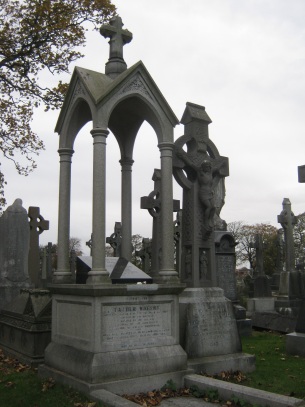
The final resting place of Msgr. James Nugent (1822 - 1905) in Ford Cemetery.
Part One
Ford Cemetery
During these grim days of November, we have been over to pray for the Holy Souls at Ford Cemetery on Merseyside.
The cemetery was established by the Roman Catholic Diocese of Liverpool back in the 1850's. Although it has since been surrounded by the sprawl of suburbia, this area remained open countryside until well into the 20th-Century.
The cemetery was originally designed with a splendid chapel of the Holy Sepulchre by Augustus Welby Pugin. Although that historical chapel has sadly been demolished, the tombs and graves of many bishops, priests, nuns and lay Catholics, dating to the earliest days of Liverpool's Roman Catholic Diocese (and now Archdiocese), remain extant.
Msgr. James Nugent and the Martyr Priests
Notable among these is the final resting place, at least on this earth, of Msgr. James Nugent (1822 - 1905); a priest whose tall statue still graces St. John's Gardens in the city of Liverpool to this day.
It was Father Nugent's special privilege to serve in his youth alongside the famous ''Martyr Priests'' of Liverpool. In 1847, a mere 18 years after Catholic Emancipation, and 3 years prior to the restoration of the Catholic Hierarchy in England, the city of Liverpool was known as the Black Spot on the Mersey. This was due to the crushing poverty and disease which was so rife in the area at that time.
In that year alone, some 300,000 fugitives landed in the city's port, hoping to escape from the famine and disease which were decimating the Irish population across the sea. Of that 300,000, between 60-80,000 remained in the city to settle or to die.
The rate of fever sent the death rate up by a distressing 2,000%. In Vauxhall ward alone, one-seventh of the population perished. Dr. W.H.Duncan, a pioneer in sanitary reform who had been appointed as a Medical Officer for the city, estimated that almost 60,000 people suffered from fever, and nearly 40,000 from diarrhoea or dysentry.
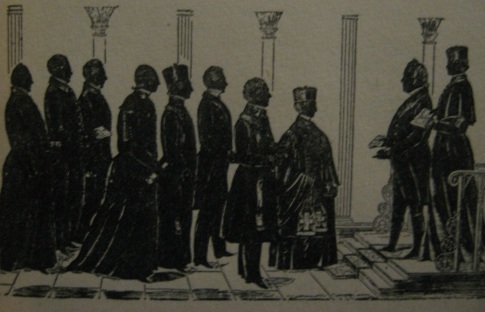
The famous ''Martyr Priests'' of Liverpool: (L-R): Fathers Dale, O.S.B., St. Mary's; Parker, St. Patrick's; Grayston, St. Patrick's; Whitaker, St. Joseph's; Gilbert, O.S.B., St. Mary's; Nightingale, St. Anthony's; Haggar, St. Patrick's; Gillow, St. Nicholas'; Appleton, D.D., O.S.B., St. Peter's; Kelly, D.D., St. Joseph's.
Thousands of immigrants kept on coming into the city, hoping to count on friends and relatives who had already arrived. It was not until they got here that they realized that these same souls were already living in shocking conditions of poverty and overcrowding.
As Canon Bennet recorded in his 1949 biography, Fr. Nugent of Liverpool: ''There were 24 priests attached to 8 Catholic chapels to cope with this ocean of misery.'' Out of those priests, at least 18 were themselves stricken down; and 10 of these sadly died.
These brave priests faced death by the hour. At night they tried to catch some rest on chairs and sofas; still clerically attired as they awaited the inevitable round of sick-calls. Sometimes, they even had to lie down next to dying individuals in order to hear their last confessions in the midst of tightly packed cellars of suffering. There were so many sick people in those places that the priests sometimes had nowhere to reverently place the pyx containing the Blessed Sacrament, except for the tops of their tall hats.
One Sunday at the historical St. Patrick's church, the Holy Mass had to be cancelled because two of the priests had died and a third was in bed battling the dreaded fever.
Canon Bennett records that these examples of priestly heroism made a deep impression on the people of Liverpool; and not only on the Catholic population.
Fifty years after these dreadful events, Msgr. Nugent preached at a solemn Mass of Requiem for the ''Martyr Priests'' at St. Patrick's church, on 16th June, 1897. His text and theme was, The Good Shepherd Gives His Life for His Sheep.
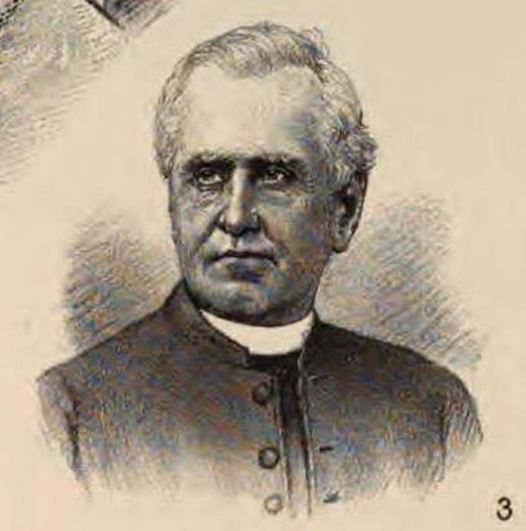
Msgr. James Nugent: Liverpool's famous and much loved priestly son. Having been blessed to work with the heroic ''Martyr priests'' in his youth, the Monsignor went on to become an important pioneer in child welfare, poverty relief and social reform. At his death the people of Liverpool lined the streets for his funeral.
Msgr. Nugent described how the ''Martyr Priests'' and their colleagues remained calm in the midst of the panic caused by the terrible scourge on the city. Day and night, those priests ministered to the sick and dying in attics, cellars, courts and alleys; places where breathing the fetid air could often mean certain death.
These priests went to such places fearlessly to save and sanctify souls with the Sacraments of Holy Church. At times, there being no-one else to perform the difficult task, these priests even lifted the festering and sore-covered bodies of the unburied dead into coffins.
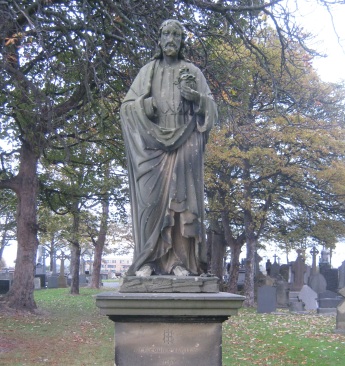
The long-vandalized statue of the Sacred Heart of Jesus at Ford Cemetery: Behold the Heart that has so loved men and yet has received so little love in return...
On the 16th June, 1847, the day that Fr. Grayston of St. Patrick's died, there were around 43 sick-calls made by the resident priests. The young James Nugent went along with Fr. Gillow to a cellar where a young mother lay dead of the fever on a heap of shavings on the cellar-floor; a baby dead at her breast and two infants playing nearby.
Fr. Gillow himself succumbed to the scourge on 22nd August that year. In the eleven years that he had served at Copperas Hill, he had introduced a High Mass every Sunday, and Benediction of the Blessed Sacrament every Sunday and Thursday. He had also established guilds for young men and women, together with the very first Conference of the St. Vincent de Paul Society in Liverpool, to bring practical aid to the suffering poor.
Fr. Robert Gillow's brother, Fr. George Gillow was also serving in the city at that tumultous time. When he died decades later, in 1894, Canon John Walmesley recounted a moving incident from the terrible days of the fever.
A messenger had hurried into the presbytery begging for someone to come and help at St. Patrick's church; where the priests were all down with the fever and corpses were beginning to fill the church. It seems that the priests looked round at each other, as if to say, ''Who will be the next victim?''
At that moment, the youthful Fr. George Gillow had quietly answered, ''I will go, if you like.'' Although he later caught the fever, Fr. George was able to fight it off and went on to live as an active priest for several more decades.
Towards the conclusion of his chapter on the ''Martyr Priests'' of Liverpool, Canon Bennett's book on Msgr. Nugent's life acknowledges the very heavy toll that sick-calls took on young priests in general during those difficult times. From a pastoral letter written by Bishop Briggs in 1840, it becomes clear that no less than 25 priests, ranging from youth to middle-age, had died in an 18-month period from diseases which they had contracted during the discharge of their sacred duties.Â
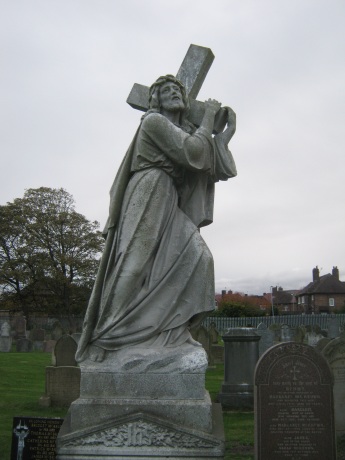
Jesus may Thy Cross defend me, and Thy saving death befriend me, cherished by Thy deathless grace: when to dust my dust returneth, grant a soul that to Thee yearneth, in Thy paradise a place (from the hymn, At the Cross Her Station Keeping).
Msgr. James Nugent would himself survive and live on to become one of north-west England's most celebrated pioneers in the fields of child welfare, poverty relief and social reform. The Nugent Care organization was orginally founded on his clear ideals.
Among Msgr. Nugent's key achievements were the establishment of charitable schools for destitute children, the Catholic Reformatory Association, the Liverpool Catholic Children's Protection Society, the Northern Press and The Catholic Times, a refuge for fallen women and a Catholic chaplaincy at Walton Gaol.
During his lifetime, Msgr. Nugent gained the respect of many people of all creeds and social classes in, and far beyond, the city of Liverpool. This was no small feat when one considers that the Catholic Church in this country was only just slowly emerging from three centuries of anti-Catholic persecution and bigotry.
Part Two
Life and Death on the Edge
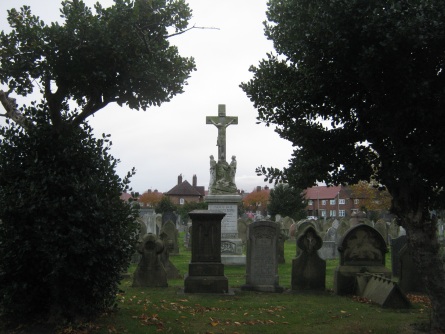
We adore Thee, O Christ, and We Praise Thy Holy Name; because by Thy Holy Cross Thou hast redeemed the world!
I actually spent the first 9 years of my life growing up with my - then still Protestant - family in a small new-build home at the edge of Ford Cemetery in Litherland, near Liverpool.
I've got to be honest and say that, in those days, Ford Cemetery seemed such a spooky old place in contrast to our modern little home across the way.
When I was only a small boy, my big brother told me a scary story one night that it was never safe to look out of the windows of our house in the hours of darkness. He suggested that the wind-battered trees at the cemetery's edge were always filled with black-cloaked skeletons, which hung from the gnarled branches, from sunset to sunrise. For years as a kid, I would never dare to peer out through the curtains after dark!
Mum and Dad also used to tell us that, in the years when they were a young courting couple - remember courting couples! - they had to pass the cemetery on their walks between Dad's family home and Mum's.
One night, a large white ''thing'' flew out of the cemetery railings right in front of them and they screamed out in fright. Maybe to reassure us little ones, Mum always smiled and said that it had only been an owl, but Dad would always insist that, no, it had been something beyond explanation.
I perhaps outgrew those particular fears before we moved house in 1981, but that cemetery remained a negative place in my imagination for other reasons as I was growing up.
The cemetery was, by then, known locally as a place where glue-sniffers - ''glewies'' in Liverpool parlance - liked to hang out in the evenings. Then again, local bad lads and lasses - ''scallies'' to a Liverpudlian - would also go in there to take part in brutal fights with bricks. In my teens I was told stories of cats being tortured in there by gangs.Â
To top it all, my own father had grown up in an older street of houses nearby. When I reached my late teens, Dad told me that a scary old woman, a person that nobody round there knew, would often come out of the cemetery at night and repeatedly ask the locals to go back in with her... He said that he had witnessed this himself a number of times!
Because of these accumulated fears and impressions, I had never desired to go too near Ford cemetery.
Indeed, although I have long known the story of Msgr. Nugent, I only discovered this year that he and so many other foundational clergy from the Archdiocese of Liverpool are buried there.
In the last few weeks, Angie, Mum and I have been to Ford Cemetery a couple of times to pray before Msgr. Nugent's grave. We've prayed for the Archdiocese of Liverpool and for the holy souls in purgatory.
I must say that, in sharp contrast to the legendary horrors of the place, I have found it to be a place of extraordinary peace and even holiness. This is often the case in places where Catholics from holier times rest on hallowed ground.
Although it is more than sad to see so many historical tombs - some of which have intricate carvings of pre-conciliar priests raising the Sacred Host complete with miniature altar servers clutching their stone chasubles - in various states of vandalism, Ford Cemetery is definitely one of those places which seems to be saturated with an atmosphere of grace.
Only Our Mother - After All!
This reality, as opposed to my previously imagined notions of the place, got me thinking about the tragedy of growing up in a country which has for so many centuries lived without the Catholic Faith; and of the grace-filled miracle of finding and entering that Faith.
There is a sense in which the Catholic Ford Cemetery symbolizes something much bigger in our culture.
Just as I grew up with various received impressions of the Ford Catholic Cemetery, so have many English men and women grown to adulthood outside of the Catholic Church in recent centuries.
I was one of them myself.
Our impressions of Catholicism were that it was a sinister and harsh religion, associated with unusual rituals and a violent and mysterious past.
That's pretty much what Ford Cemetery was also like in my imagination.
And yet the reality of the cemetery, as of the True Church, is that it is really a place where holy men and women rest and find a home in the peace of Christ. True, it has been battered by invaders, but it still maintains that essential spiritual calm.
What a blessing it has been to recently find Msgr. Nugent's grave and thus be able to pray there. What a wonder it was to learn, too, that Canon Michael Culhane, the good priest who received Mum, Dad and I into the Catholic Church over 20 years ago, is buried just nearby. What an unimagined gift it has been to discover the Holy Sacrifice of the Mass, the Rock of Peter and the pillars of Sacred Scripture, Tradition and the Magisterium.
And how sad that so many of us Englishmen and women might miss our annunciations by living just outside of these beautiful, saving mysteries. Just across the way in our little modern worlds we thought, like so many Miss Havershams, that our curtains were keeping out the dark, when all along they were obstructing the light.
How many Liverpool people have even heard of Msgr. Nugent today? How few, even in Catholic parishes and schools have learned that ours is the One True Church, the True Faith, which was founded by Our Lord Jesus Christ for our salvation and sanctification!
Let us conclude with a fun little story, which also sheds some further light on the things we are reflecting on here.
Whilst in Ford Cemetery recently, I was so emamoured of praying near to the tombs of Msgr. Nugent and various Catholic bishops, monks, priests and nuns, from holier times than these, that I agreed for Angie and Mum to go off for a while and return to meet me later on.
I was so deep in reflection by Msgr. Nugent's tomb, that I did not hear them returning later on to pick me up. Neither did I even hear them approaching behind me through the grass and various stone tombs...
I can tell you that when my poor Mum, who lives in daily confusion after suffering a severe stroke a couple of years back, suddenly took hold of my hand from behind that I nearly jumped 1,000 feet in the air!
Who-ho-ha-ha-aagh-aaghhhhhhhhh!!!!!!
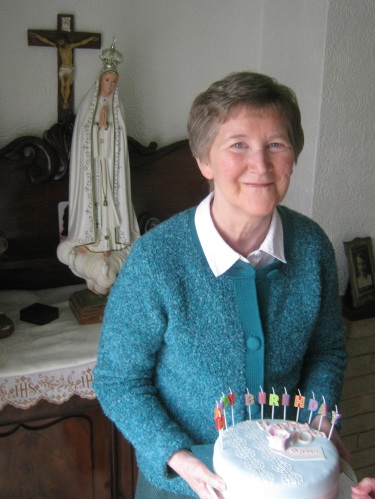
Mum celebrating her 70th birthday by our home altar earlier this year.
How joyful I was to turn round and see that, beyond my fears, it had only been my dear, smiling little mother all along.
And that is really the message that I would love to impart to all the poor souls who live out their lives just across the way from the Catholic Church in the post-Catholic society which has developed through the progressive turmoils of: the Protestant Revolution; the Rationalist Revolution; the Industrial Revolution; the World Wars; the Sexual Revolution; and now the Post-Modern Revolution.
There we all were, thinking the Church was something frightening, unknown and demanding, when all along She was only our Mother reaching out to greet us.
Our Lady of Walsingham - Pray for us!



